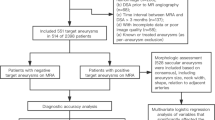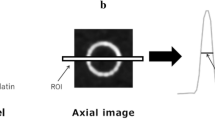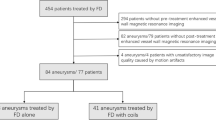Abstract
Purpose
Flow diverters (FD) have poor radiopacity, challenging visualization of deployment and vessel wall apposition with conventional neuroimaging modalities. We evaluated a novel cone beam computed tomography (CT) imaging technique that allows virtual dilution (VD) of contrast media to facilitate workflow and ensure accurate assessment of FD wall apposition.
Methods
We retrospectively evaluated all patients treated for intracranial aneurysms with FD at our institution between November 2018 and November 2019. Undiluted injected dual cone beam CT acquisitions performed post-stenting were displayed with VD software (GE Healthcare). The resulting images were compared with conventional two-dimensional (2D) digital subtraction angiography (DSA) images. Two neurointerventionalists (Reader 1 and Reader 2, (R1, R2)) independently assessed FD deployment and wall apposition. Confidence in the diagnosis, inter-reader agreement, and X-ray exposure were assessed.
Results
A total of 27 cases were reviewed. FD deployment and wall apposition scores were 4.2 ± 1.0 (R1) and 4.0 ± 1.1 (R2) for DSA and 3.7 ± 1.2 (R1) and 4.1 ± 1.0 (R2) for VD. Confidence in the diagnosis was improved with VD, with scores of 3.7 ± 0.7 (R1) and 4.0 ± 0.7 (R2) using DSA and 4.9 ± 0.2 (R1) and 4.9 ± 0.2 (R2) using VD (P < 0.001). Inter-reader agreement using 2D DSA was improved from moderate (0.49324) to good (0.7272) (P < 0.0001). There were no significant differences in inter-reader agreement in the deployment assessment (P = 0.68) or dose-area product (P = 0.54) between techniques.
Conclusion
VD imaging with dual cone beam CT enables accurate assessment of FD wall apposition after deployment with greater confidence and improved inter-reader agreement versus conventional 2D DSA alone, with comparable X-ray exposure.




Similar content being viewed by others
References
Kallmes DF, Hanel R, Lopes D, Boccardi E, Bonafe A, Cekirge S, Fiorella D, Jabbour P, Levy E, McDougall C, Siddiqui A, Szikora I, Woo H, Albuquerque F, Bozorgchami H, Dashti SR, Delgado Almandoz JE, Kelly ME, Turner R, Woodward BK, Brinjikji W, Lanzino G, Lylyk P (2015) International retrospective study of the pipeline embolization device: a multicenter aneurysm treatment study. AJNR Am J Neuroradiol 36(1):108–115. https://doi.org/10.3174/ajnr.A4111
Brinjikji W, Murad MH, Lanzino G, Cloft HJ, Kallmes DF (2013) Endovascular treatment of intracranial aneurysms with flow diverters: a meta-analysis. Stroke 44(2):442–447. https://doi.org/10.1161/STROKEAHA.112.678151
Kizilkilic O, Kocer N, Metaxas GE, Babic D, Homan R, Islak C (2012) Utility of VasoCT in the treatment of intracranial aneurysm with flow-diverter stents. J Neurosurg 117(1):45–49. https://doi.org/10.3171/2012.4.JNS111660
Ding D, Starke RM, Durst CR, Gaughen JR Jr, Evans AJ, Jensen ME, Liu KC (2014) DynaCT imaging for intraprocedural evaluation of flow-diverting stent apposition during endovascular treatment of intracranial aneurysms. J Clin Neurosci 21(11):1981–1983. https://doi.org/10.1016/j.jocn.2014.04.003
Heller R, Calnan DR, Lanfranchi M, Madan N, Malek AM (2013) Incomplete stent apposition in Enterprise stent-mediated coiling of aneurysms: persistence over time and risk of delayed ischemic events. J Neurosurg 118(5):1014–1022. https://doi.org/10.3171/2013.2.JNS121427
Rouchaud A, Ramana C, Brinjikji W, Ding YH, Dai D, Gunderson T, Cebral J, Kallmes DF, Kadirvel R (2016) Wall apposition is a key factor for aneurysm occlusion after flow diversion: a histologic evaluation in 41 rabbits. AJNR Am J Neuroradiol 37(11):2087–2091. https://doi.org/10.3174/ajnr.A4848
Ahmed SU, Mocco J, Zhang X, Kelly M, Doshi A, Nael K, De Leacy R (2019) MRA versus DSA for the follow-up imaging of intracranial aneurysms treated using endovascular techniques: a meta-analysis. J Neurointerv Surg 11(10):1009–1014. https://doi.org/10.1136/neurintsurg-2019-014936
Yuki I, Kambayashi Y, Ikemura A, Abe Y, Kan I, Mohamed A, Dahmani C, Suzuki T, Ishibashi T, Takao H, Urashima M, Murayama Y (2016) High-resolution C-arm CT and metal artifact reduction software: a novel imaging modality for analyzing aneurysms treated with stent-assisted coil embolization. AJNR Am J Neuroradiol 37(2):317–323. https://doi.org/10.3174/ajnr.A4509
Reyes D, Becerra V, Alcala I, Linfante I, Dabus G (2018) Usefulness of cone beam intra-arterial CTA for evaluation of flow diverters: a practical approach for daily use. Interv Neurol 7(6):457–463. https://doi.org/10.1159/000490577
Kuriyama T, Sakai N, Beppu M, Sakai C, Imamura H, Masago K, Katakami N, Isoda H (2018) Quantitative analysis of cone beam CT for delineating stents in stent-assisted coil embolization. AJNR Am J Neuroradiol 39(3):488–493. https://doi.org/10.3174/ajnr.A5533
Clarencon F, Di Maria F, Gabrieli J, Shotar E, Degos V, Nouet A, Biondi A, Sourour NA (2017) Clinical impact of flat panel volume CT angiography in evaluating the accurate intraoperative deployment of flow-diverter stents. AJNR Am J Neuroradiol 38(10):1966–1972. https://doi.org/10.3174/ajnr.A5343
Srinivasan VM, Chintalapani G, Camstra KM, Effendi ST, Cherian J, Johnson JN, Chen SR, Kan P (2018) Fast acquisition cone-beam computed tomography: initial experience with a 10 s protocol. J Neurointerv Surg. 10(9):916–920. https://doi.org/10.1136/neurintsurg-2017-013475
Kellermann R, Serowy S, Beuing O, Skalej M (2019) Deployment of flow diverter devices: prediction of foreshortening and validation of the simulation in 18 clinical cases. Neuroradiology. 61:1319–1326. https://doi.org/10.1007/s00234-019-02287-w
Kato N, Yuki I, Ishibashi T, Ikemura A, Kan I, Nishimura K, Kodama T, Kaku S, Abe Y, Otani K, Murayama Y (2019) Visualization of stent apposition after stent-assisted coiling of intracranial aneurysms using high resolution 3D fusion images acquired by C-arm CT. J Neurointerv Surg 12:192–196. https://doi.org/10.1136/neurintsurg-2019-014966
Ionita CN, Natarajan SK, Wang W, Hopkins LN, Levy EI, Siddiqui AH, Bednarek DR, Rudin S (2011) Evaluation of a second-generation self-expanding variable-porosity flow diverter in a rabbit elastase aneurysm model. AJNR Am J Neuroradiol 32(8):1399–1407. https://doi.org/10.3174/ajnr.A2548
Makoyeva A, Bing F, Darsaut TE, Salazkin I, Raymond J (2013) The varying porosity of braided self-expanding stents and flow diverters: an experimental study. AJNR Am J Neuroradiol 34(3):596–602. https://doi.org/10.3174/ajnr.A3234
Chintalapani G, Chinnadurai P, Maier A, Xia Y, Bauer S, Shaltoni H, Morsi H, Mawad ME (2016) The added value of volume-of-interest C-arm CT imaging during endovascular treatment of intracranial aneurysms. AJNR Am J Neuroradiol 37(4):660–666. https://doi.org/10.3174/ajnr.A4605
Acknowledgments
The authors acknowledge Superior Medical Experts for research and drafting assistance.
Contributors
Material preparation, data collection, and analysis were performed by Dr. Ameer Hassan, Dr. Tekle Wondwossen, and Mr. Jim Wise. Ms. Elizabeth Burke drafted the article, and all authors provided critical interpretation and revisions and approved the final manuscript.
Funding
This study was supported by a research grant from GE Healthcare.
Author information
Authors and Affiliations
Corresponding author
Ethics declarations
Conflict of interest
AEH serves as a consultant and speaker for GE Healthcare, Medtronic, Stryker, Microvention, Penumbra, Balt USA, and Genentech. JW is employed by GE Healthcare. EMB contracts with Superior Medical Experts. WGT has no conflicts of interest to disclose.
Ethical approval
All procedures performed in studies involving human participants were in accordance with the ethical standards of the institutional and/or national research committee and with the 1964 Helsinki declaration and its later amendments or comparable ethical standards.
Informed consent
Patient informed consent was waived because of the retrospective nature of the study design.
Additional information
Publisher’s note
Springer Nature remains neutral with regard to jurisdictional claims in published maps and institutional affiliations.
Rights and permissions
About this article
Cite this article
Hassan, A.E., Wise, J., Burke, E.M. et al. Visualization of flow diverter stent wall apposition during intracranial aneurysm treatment using a virtually diluted cone beam CT technique (Vessel ASSIST). Neuroradiology 63, 125–131 (2021). https://doi.org/10.1007/s00234-020-02507-8
Received:
Accepted:
Published:
Issue Date:
DOI: https://doi.org/10.1007/s00234-020-02507-8




